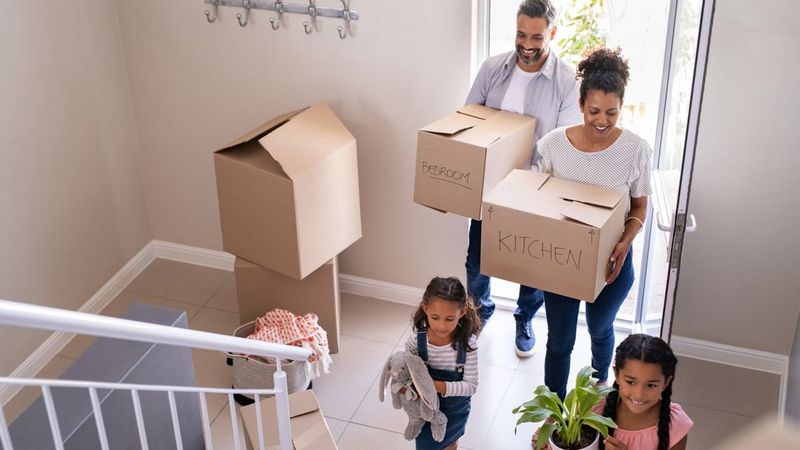
Tips for Moving Into a New Home
Moving into a new home can be a daunting and overwhelming process. From packing up your belongings to settling into your new space, there are many tasks that require careful organization and planning. Fortunately, with the right tips and advice, you can make this transition as smooth and stress-free as possible.
One of the most important steps in the moving process is packing. It’s essential to pack your belongings in an organized and efficient manner to ensure a smooth unpacking process later on. Start by sorting and decluttering your items, donating or selling anything you no longer need. Then, pack your items by category and label each box clearly. This will make it much easier to find specific items when you’re unpacking in your new home.
When it comes to unpacking, a little bit of planning goes a long way. Before you start unpacking, take the time to envision how you want your new space to look and function. This will help you determine the best placement for your furniture and belongings. Start with the essentials and gradually unpack and arrange the rest of your items. Remember, unpacking doesn’t have to be done all at once. Take your time and enjoy the process of making your new space feel like home.
Seeking expert advice can also be incredibly helpful when moving into a new home. From professional movers to interior designers, there are professionals who can provide valuable insights and assistance throughout the moving process. Whether it’s advice on furniture placement or tips on creating a functional and stylish living space, their expertise can ensure that your new home is both comfortable and functional.
Plan your move in advance
Moving to a new home can be an exciting but daunting experience. To ensure a smooth transition, it is crucial to plan your move well in advance. By properly organizing and preparing for the move, you can minimize stress and make the process much more manageable.
Unpacking Strategy:
- Before you start packing, it is essential to plan where your furniture and belongings will go in your new home. By creating a floor plan and deciding on the placement of furniture ahead of time, you can save yourself a lot of time and effort during the unpacking process.
- Labeling your boxes with clear descriptions of the contents and the room they belong to will make unpacking a breeze. This way, you know exactly where each box needs to go, saving you the trouble of sorting through multiple boxes.
- Consider packing an essentials box. This box should contain items that you will need immediately upon arrival, such as toiletries, a change of clothes, and important documents. Keeping this box easily accessible will help you settle into your new home without any hiccups.
Planning for the Move:
- Start early to give yourself enough time to prepare. Moving can be a time-consuming process, so allow yourself plenty of time to organize, pack, and tie up any loose ends before the moving day.
- Make a checklist of all the tasks you need to complete before, during, and after the move. This will help you stay on top of things and ensure that nothing gets overlooked.
- If you have a lot of items to move, consider hiring professional movers. They have the experience and equipment to handle the job efficiently and safely, making the moving process much easier for you.
- Notify relevant parties, such as your utility companies, about your move well in advance. This will give them time to transfer or disconnect services, ensuring that you have a smooth transition into your new home.
Settling In:
- Once you have moved into your new home, take the time to clean and organize it before you start unpacking. This will make the process more enjoyable and help you feel more settled in your new space.
- Prioritize the unpacking of essential items first, such as kitchen supplies, bedding, and toiletries. This will allow you to function comfortably in your new home, even if there are still boxes to be unpacked.
- Take breaks and pace yourself during the unpacking process. Moving can be physically and mentally exhausting, so it’s important to take care of yourself and not overexert yourself.
- Don’t rush the process of settling into your new home. Take the time to explore your new neighborhood, meet your neighbors, and make your new space feel like home.
Final Thoughts:
Moving to a new home can be a complex and challenging task, but with proper planning and organization, you can make the process much smoother. Follow these tips to ensure a successful and stress-free move into your new home.
Declutter and organize your belongings
One of the most important tasks when moving into a new home is to declutter and organize your belongings. This will not only make the moving process easier but also help you settle into your new space more quickly and efficiently.
Here are some tips to help you declutter and organize your belongings:
- Start early: Begin the decluttering process well before your moving day. This will give you enough time to sort through your items and make decisions on what to keep, donate, or throw away.
- Go room by room: Instead of tackling the entire house at once, break it down into smaller tasks by going room by room. This will make the process more manageable and less overwhelming.
- Sort your items: Create separate piles for items you want to keep, donate, or throw away. Be honest with yourself and only keep items that you truly need or have a strong sentimental value.
- Donate or sell: Consider donating or selling items that you no longer need. This not only helps others in need but also reduces the amount of things you need to move.
- Maximize storage: Before unpacking, think about the storage options in your new home. This will help you plan where to put each item and ensure that everything has a designated place.
- Label boxes: As you pack, label each box with its contents and the room it belongs to. This will make unpacking much easier and save you time searching for specific items.
- Unpack strategically: When it’s time to unpack, start with essential items such as bedding, toiletries, and kitchen essentials. Then, unpack room by room, focusing on one area at a time.
By decluttering and organizing your belongings, you will not only create a more organized and functional space in your new home but also reduce the amount of unnecessary items that you have to move. Follow these tips for a smoother and more enjoyable moving experience.
Pack smartly and efficiently
When it comes to moving into a new home, packing is a crucial step that requires careful planning and organization. Here are some tips to help you pack smartly and efficiently:
- Create a packing schedule: Start packing well in advance to avoid last-minute rush. Make a schedule and allocate specific tasks for each day or week leading up to the moving day.
- Gather packing supplies: Gather all the necessary packing supplies such as boxes, tape, bubble wrap, packing paper, and markers. Having everything ready will save you time and effort.
- Sort and declutter: Before you start packing, go through your belongings and sort them into categories – keep, donate, and discard. Decluttering will not only save space but also make unpacking and settling into your new home easier.
- Pack room by room: Focus on packing one room at a time. This will help you stay organized and keep track of your belongings. Label each box with the room it belongs to for easy unpacking.
- Protect fragile items: Use bubble wrap, packing paper, or blankets to protect fragile items such as dishes, glassware, and electronics. Place them securely in padded boxes or wrap them individually to prevent any damage during the move.
- Utilize space efficiently: Maximize the space in your boxes by filling them to their full potential. Use towels, clothing, or newspaper to fill any gaps and provide cushioning. This will not only save you money on extra boxes but also protect your items during transport.
- Keep essentials separate: Pack a separate bag or box with essential items that you will need immediately upon arrival at your new home. Include toiletries, a change of clothes, important documents, and any other items that you might need right away.
- Document your items: As you pack, create an inventory list of all your belongings. This will help you keep track of everything and ensure that nothing gets lost or left behind.
- Ask for help: Don’t hesitate to ask friends or family members for help with packing. Having an extra set of hands can make the process faster and more efficient.
By packing smartly and efficiently, you can make the moving process smoother and less stressful. Follow these tips and you’ll be well-prepared for your new home!
Label your boxes clearly
When you’re moving into a new home, it’s essential to label your boxes clearly. This simple tip can save you a lot of time and frustration when it comes to unpacking and settling into your new space.
Why is labeling important?
Labeling your boxes helps you stay organized during the moving process. When each box is clearly labeled with its contents and destination room, you can easily find what you need without having to open every box. This is especially helpful when you’re looking for specific items, such as kitchen supplies or bedding.
How to label your boxes
There are a few strategies you can use to label your boxes effectively:
- Use a black permanent marker: A bold, legible marker will ensure that your labels are easy to read. Write the contents of the box and the room it belongs to on every side of the box for easy visibility.
- Color-code your boxes: Assign a specific color to each room in your new home. Use colored markers or colored labels to match the boxes to the corresponding room. This method is especially useful if you have movers helping you, as they can quickly identify where each box should go.
- Create an inventory list: Keep track of the contents of each box by creating an inventory list. Number each box and write down a detailed list of what’s inside. This will come in handy later if you’re searching for a specific item.
- Use “Open Me First” labels: Designate a few boxes as “Open Me First.” These boxes should contain essentials that you’ll need right away, such as toiletries, a change of clothes, and important documents. Labeling them clearly will help you prioritize and find these items quickly.
Final thoughts
Labeling your boxes clearly is a small step that can make a big difference when moving into a new home. Take the time to label each box properly, and you’ll thank yourself when it’s time to unpack and settle in.
For more helpful tips on moving and setting up your new home, be sure to check out our other articles.
Hire professional movers or rent a moving truck
When it comes to moving into a new home, one of the most important decisions you’ll have to make is whether to hire professional movers or rent a moving truck. Both options have their pros and cons, so it’s important to consider your specific needs and budget before making a decision.
If you choose to hire professional movers, you’ll save yourself the hassle of packing and unpacking your belongings. Movers have the experience and expertise to efficiently and safely pack your items, ensuring that everything arrives at your new home in one piece. They also have the necessary equipment and organization skills to handle heavy furniture and fragile items, minimizing the risk of damage.
On the other hand, if you decide to rent a moving truck, you’ll have more control over the moving process. Renting a truck allows you to pack and organize your belongings according to your own preferences, which can be especially helpful if you have valuable or sentimental items that require special care. Renting a truck is also typically less expensive than hiring professional movers, making it a more budget-friendly option.
Before making a decision, consider the size and complexity of your move. If you have a large home with many rooms and multiple floors, hiring professional movers may be the best choice. They will have the manpower and resources to handle the logistics of your move. On the other hand, if you have a smaller home or apartment and don’t mind the extra work, renting a truck can be a cost-effective solution.
Ultimately, the decision to hire professional movers or rent a moving truck depends on your personal preferences, budget, and the specific needs of your move. Whichever option you choose, be sure to do your research and read reviews to find reputable movers or rental companies. This will help ensure a smooth and successful move into your new home.
Notify important parties of your address change
Moving into a new home involves a lot of unpacking, moving furniture, and organization. However, one important step that should not be overlooked is notifying important parties of your address change. This will ensure that all necessary communication and services are seamlessly transferred to your new home.
Here are some essential parties that you should notify:
- Post Office: Contact your local post office to inform them of your new address. They will provide you with a change of address form to fill out and forward your mail to the new location.
- Utility Companies: Notify your utility companies, such as electricity, water, gas, and internet providers, of your new address. This will ensure that your services are properly transferred or disconnected.
- Banks and Financial Institutions: Update your address information with your bank, credit card companies, and any other financial institutions you may be associated with. This will ensure that all important documents and statements are sent to the correct address.
- Government Agencies: Inform government agencies, such as the IRS, Social Security Administration, and the Department of Motor Vehicles, about your change of address. This will ensure that you receive any important government correspondence.
- Insurance Companies: Contact your insurance companies, including health, auto, and homeowner’s insurance, to update your address. This will ensure that you receive any important policy updates or claims information.
It is also a good idea to notify other important parties, such as your employer, schools, doctors, and any subscription or membership services you may have. Additionally, consider creating a list of all the parties you need to notify and checking them off as you go to ensure that you don’t miss anyone.
In conclusion, notifying important parties of your address change is an essential step when moving into a new home. By taking the time to inform them, you can ensure a smooth transition and avoid any disruptions in communication or services.
Transfer or set up utilities
When moving into a new home, one of the most important tasks to take care of is transferring or setting up utilities. It’s essential to have basic services such as electricity, water, and gas ready before you start unpacking and settling in.
Here are some essential steps to follow for transferring or setting up utilities:
- Research utility providers: Start by researching the utility providers in your new area. Find out which companies provide electricity, water, gas, internet, and other services you may need. Make a list of their contact information and any important details.
- Contact current providers: If you are moving within the same town or city, contact your current utility providers to inform them about your move. Ask them if it’s possible to transfer your services to your new address. Provide them with the necessary details and any change in dates.
- Set up new services: If you are moving to a new town or city, you will need to set up new utility services. Contact the providers in your new area and inquire about the process. They will guide you through the necessary steps and requirements for setting up new accounts.
- Transfer or disconnect: If transferring utility services, schedule a date for the transfer to take place. Make sure the utilities at your new home are activated before you move in. If disconnecting services, coordinate the disconnection with the move-out date from your current home to avoid any gaps in service.
- Notify necessary parties: It’s important to notify the necessary parties about your change of address. Update your address with the utility providers, as well as other institutions such as banks, insurance companies, and government agencies. This will ensure that important correspondence reaches you at your new home.
- Check for additional services: Aside from basic utilities, consider if you need any additional services in your new home. These can include home security systems, cable or satellite TV, and garbage collection. Research the available providers in your area and make the necessary arrangements.
A smooth and timely transfer or setup of utilities will ensure that your new home is ready for your arrival. By taking these steps, you can focus on other aspects of the moving process, such as packing, furniture organization, unpacking, and settling into your new home.
Change your mailing address
Moving into a new home involves a lot of settling and unpacking, but one essential step that often gets overlooked is changing your mailing address. Remember to update your address with the post office and any other important contacts to ensure you don’t miss any important mail. Here are some helpful tips for changing your mailing address:
- Contact the post office: Visit your local post office branch or go online to fill out a change of address form. This will ensure that your mail is forwarded to your new address for a specified period of time.
- Update important contacts: Make a list of all the important contacts who need to be notified of your address change. This may include banks, credit card companies, insurance providers, and any other organizations that regularly mail you important documents. Notify them of your new address so they can update their records.
- Notify friends and family: Inform your friends and family of your new address so they can update their contact information for you. This will ensure that any cards, letters, or packages sent to you will be delivered to the correct location.
- Update online accounts: If you have any online accounts that require your address, such as online shopping websites or subscription services, log in and update your information. This will help ensure that any future orders or deliveries are sent to the correct address.
By taking the time to change your mailing address, you can ensure that all of your important mail is delivered to your new home. This simple step will help with the overall organization and settling process after moving, allowing you to focus on unpacking and arranging furniture in your new space.
Unpack and set up your essentials first
Once you have completed the moving process and have arrived at your new home, the next step is to unpack and organize your belongings. This can seem overwhelming, but with some careful planning and preparation, you can make the process easier and more efficient.
To start, it is important to unpack and set up your essentials first. These are the items that you will need immediately upon settling into your new home. By prioritizing these items, you can ensure that you have everything you need to function comfortably in your new space.
Here are some tips to help you unpack and set up your essentials:

- Create an unpacking plan: Before starting the unpacking process, take some time to create a plan. Decide which rooms you want to unpack first and make a list of the essential items that you want to set up in each room.
- Focus on one room at a time: Instead of overwhelming yourself by trying to unpack your entire home at once, focus on unpacking one room at a time. This will help you stay organized and make the process more manageable.
- Unpack room by room: Within each room, unpack one box at a time. Start with the essentials and then move on to the non-essential items. This will help you prioritize and ensure that you have the essentials set up and easily accessible.
- Set up your bedroom first: Your bedroom is one of the most important rooms in your home. It is where you will be spending a significant amount of time, so it is important to set it up first. Make sure you have a comfortable bed to sleep on and essential items like pillows, sheets, and blankets readily available.
- Focus on the kitchen: The kitchen is another essential area of your home. Make sure to unpack and set up your kitchen essentials, such as cookware, utensils, and dishes. This will allow you to prepare meals and feel more at home.
- Start with the bathroom: After unpacking your bedroom and kitchen, focus on setting up your bathroom essentials. Stock up on toiletries, towels, and any other personal items you need on a daily basis.
By following these tips and prioritizing the unpacking and setup of your essentials, you can ensure a smooth transition into your new home. Take your time, stay organized, and enjoy the process of turning your new house into a home.
Take inventory of your belongings
Before you start the process of moving into your new home, it’s important to take inventory of your belongings. This will help you stay organized throughout the moving process and ensure nothing gets lost or left behind.
Here are some tips to help you with this task:
- Create a checklist: Start by creating a checklist of all the items you have in your current home. This can serve as a guide for both packing and unpacking.
- Categorize your belongings: Divide your belongings into different categories such as furniture, kitchenware, electronics, clothing, etc. This will make it easier to keep track of everything.
- Take photos: Take photos of valuable or fragile items before packing them. This will be useful for insurance purposes in case any damage occurs during the move.
- Label your boxes: As you pack your belongings, label each box with its contents and the room it belongs to. This will make unpacking much easier and efficient.
- Consider decluttering: Moving is a great opportunity to declutter and get rid of items you no longer need or use. This will make your new home feel more organized and spacious.
- Create a spreadsheet or use a mobile app: If you prefer a digital approach, you can create a spreadsheet or use a mobile app to keep track of your belongings. This can be especially helpful if you have a large number of items.
By taking inventory of your belongings, you’ll have a better sense of what you own and how to organize it in your new home. This process will also help you prioritize which items to unpack first and ensure a smoother settling-in process.
Update your insurance policies
One important task to take care of when moving into a new home is updating your insurance policies. This is crucial to ensure that you have proper coverage for your new home. Here are some tips to help you with this process.
- Contact your insurance provider: Get in touch with your insurance provider as soon as possible to inform them about your upcoming move. They will be able to guide you on the necessary steps to update your policies.
- Review your current policies: Take the time to review your current insurance policies to understand what they cover. Make note of any changes you might need to make based on the new home and its contents.
- Assess your new home’s risk factors: Evaluate any potential risks associated with your new home, such as its location, weather conditions, or neighborhood. This will help you determine if you need additional coverage for specific risks.
- Consider additional coverage: Depending on your assessment of the new home’s risk factors, you may want to consider adding additional coverage to your policies. This could include coverage for natural disasters, theft, or liability.
- Update coverage for valuable items: If you have valuable items, such as expensive electronics or jewelry, make sure you update your insurance coverage to protect these items adequately.
- Document your belongings: Before unpacking and settling into your new home, take inventory of your belongings. This will help you in case you need to file a claim in the future. Consider taking photos or videos of your furniture, electronics, and other valuable items.
- Understand policy limits and deductibles: Review the policy limits and deductibles of your insurance policies to ensure they align with your needs and budget. Make any necessary adjustments if needed.
By taking the time to update your insurance policies before settling into your new home, you can have peace of mind knowing that you are adequately covered in the event of any unforeseen circumstances.
Familiarize yourself with the new neighborhood
Moving into a new home involves a lot of organization and packing, but it’s also important to take the time to familiarize yourself with the new neighborhood. Whether you’re moving to a new city or just a different part of town, getting to know your new surroundings can help you settle into your new home more easily and quickly.
Here are some tips to help you get acquainted with your new neighborhood:
- Take a walk or drive around: Explore the streets around your new home by going for a walk or driving around the neighborhood. This will give you a better idea of the layout and what amenities are nearby.
- Visit local shops and businesses: Check out the local shops, restaurants, and businesses in the area. This will not only help you discover new places to eat and shop, but it will also give you a sense of the neighborhood’s character and community.
- Talk to your neighbors: Introduce yourself to your new neighbors and strike up conversations with them. They can provide valuable insights about the neighborhood, such as the best schools, parks, and community events.
- Research nearby amenities: Look up nearby amenities such as grocery stores, pharmacies, parks, and recreational facilities. Knowing where these essential services are located will make it easier to settle into your new home.
- Join local community groups and organizations: Get involved in local community groups and organizations. This can include joining neighborhood watch programs, attending homeowner association meetings, or participating in volunteer activities. These groups are a great way to meet new people and become an active member of your new community.
By familiarizing yourself with your new neighborhood, you can make the process of settling into your new home much smoother. Taking the time to explore, meet your neighbors, and get involved in the community can help you feel more connected and comfortable in your new surroundings. So don’t forget to add these tips to your moving checklist!
Find local service providers and resources
When moving into a new home, it’s essential to find reliable local service providers and resources to assist with various aspects of the moving process. Here are some tips to help you find the right professionals and tools:
- Ask for recommendations: Reach out to friends, family, and coworkers who have recently moved to get recommendations for local service providers. They can provide insights into reliable companies and resources in your area.
- Online directories: Utilize online directories to find local service providers and resources. Websites like Yelp, Angie’s List, and HomeAdvisor can help you find movers, packers, and other professionals in your area.
- Local newspapers: Check local newspapers for advertisements from service providers offering their assistance with moving. These advertisements often include contact information and details about the services they offer.
- Moving companies: Research moving companies in your area and compare their services, prices, and customer reviews. Look for companies that are licensed and insured to ensure the safety of your furniture and belongings.
- Professional packers: If you need help with packing your belongings, consider hiring professional packers. They can efficiently and securely pack your items, saving you time and effort.
Once you have found local service providers, contact them to discuss your specific needs, request quotes, and inquire about their availability. It’s important to start this process well in advance to secure their services on your desired moving date.
By finding reliable local service providers and resources, you can make your move into a new home smoother and more convenient. From packing and unpacking your furniture to settling into your new space, their assistance can ensure a stress-free moving experience.
Get to know your new home’s maintenance needs
Moving into a new home is an exciting time, but it’s also important to familiarize yourself with your new home’s maintenance needs. Taking the time to understand the specific requirements of your new home will help you keep it in good condition and avoid potential issues down the road. Here are some tips to help you get started:
- Inspect the property: Take a thorough walk-through of your new home and make note of any existing issues, such as leaky faucets or damaged walls. This will help you prioritize any repairs or maintenance tasks that need to be addressed.
- Create a maintenance schedule: Develop a regular maintenance schedule for tasks such as cleaning gutters, replacing air filters, and inspecting smoke detectors. This will help you stay on top of routine maintenance and prevent any small issues from turning into major problems.
- Learn about the HVAC system: Find out how to operate your new home’s heating, ventilation, and air conditioning (HVAC) system. Understand how to change filters, adjust thermostats, and identify any potential signs of trouble. Regular HVAC maintenance is essential for keeping your home comfortable and energy efficient.
- Take care of the landscape: If your new home has a yard or outdoor space, it’s important to understand the maintenance requirements for the landscaping. Learn how to care for any plants, trees, or grass and develop a plan for regular lawn care and gardening.
- Test and familiarize yourself with the utilities: Make sure you know where the main shut-off valves for water, gas, and electricity are located. Familiarize yourself with the electrical panel and know how to reset any tripped breakers. Testing the utilities will help you identify any issues and ensure everything is in working order.
Prioritizing the maintenance needs of your new home will help you settle in more smoothly and give you peace of mind. By staying organized and proactive, you can ensure that your new home remains in excellent condition for years to come.
Meet your neighbors
When moving to a new home, it’s important to reach out and meet your new neighbors. Building a strong sense of community not only enhances your living experience but can also be beneficial in terms of safety, organization, and settling into your new environment. Here are some tips on how to meet your neighbors:
- Introduce yourself: Take the initiative to introduce yourself to your neighbors. Knock on their doors or approach them when you see them outside. A simple “Hi, I’m [Your Name], I just moved in next door” can go a long way.
- Attend neighborhood events: Keep an eye out for any neighborhood events or gatherings and make an effort to attend. This could be a block party, a community picnic, or even a neighborhood watch meeting. These events provide a great opportunity to meet multiple neighbors at once.
- Join community groups: Look for community groups or organizations in your new area that align with your interests. Whether it’s a sports team, book club, or volunteering opportunities, getting involved in these groups can help you meet like-minded neighbors.
- Offer small gestures: Show your goodwill by offering small gestures such as bringing over a homemade treat or a small gift to your neighbors. This can help break the ice and create a friendly atmosphere.
- Explore local amenities together: Ask your neighbors for recommendations on nearby parks, restaurants, or other amenities. Offer to explore these places together to build a connection and learn more about your new neighborhood.
Remember, getting to know your neighbors is a gradual process. It may take time to establish relationships, but investing in these connections can greatly enhance your experience in your new home.
Create a new home checklist and routine
Moving into a new home can be both exciting and overwhelming. To ensure a smooth transition and make the process less stressful, it is essential to create a new home checklist and establish a routine. Here are some tips to help you get started:
1. Furniture and belongings
- Make an inventory of your furniture and belongings before packing.
- Consider whether any items need to be sold, donated, or discarded.
- Measure your new home to determine if your existing furniture will fit properly.
- Create a detailed plan for where each piece of furniture will go in the new home.
2. Packing and unpacking
- Gather packing supplies such as boxes, bubble wrap, and packing tape.
- Label each box with its contents and the room it belongs to.
- Start packing non-essential items well in advance to avoid last-minute rush.
- Organize boxes based on priority, unpacking essential items first.
3. Settling in and organization
- Create a designated space for important documents and keep them organized.
- Set up essential utilities such as electricity, water, and internet.
- Take time to explore your new neighborhood and locate nearby amenities.
- Establish a routine for maintaining cleanliness and organization in your new home.
4. Additional tips
- Notify relevant parties of your change of address, including post office, bank, and utility companies.
- Check that all appliances and fixtures in the new home are in working order.
- Make a list of any necessary repairs or improvements needed in your new home.
- Consider hiring professional movers if you have heavy or valuable items.
By following these tips and creating a checklist and routine, you can make the process of moving into your new home much easier and smoother. Remember to take breaks and ask for help when needed to reduce stress and enjoy the excitement of starting a new chapter in your life!
Keep a copy of important documents in a safe place
When moving into a new home, it’s essential to be organized and prepared. One important step in the moving process is to keep a copy of important documents in a safe place. These documents can include:
- Lease agreement: If you’re renting your new home, make sure you have a copy of the lease agreement handy. This document outlines the terms and conditions of your tenancy, including rent payment schedule, deposit amount, and any rules or regulations you need to follow.
- Homeowner’s insurance: If you’ve purchased a new home, it’s crucial to have a copy of your homeowner’s insurance policy. This document protects your home and belongings in the event of theft, accidents, or natural disasters, so make sure you have it readily available.
- Identification documents: Keep copies of your identification documents, such as your driver’s license, passport, and social security card, in a safe place. These documents are crucial for various purposes, including setting up utilities, updating your address, and completing any necessary paperwork.
- Financial records: It’s also important to keep copies of your financial records, such as bank statements, tax returns, and any loan or mortgage documents. These documents can be useful when applying for a new mortgage, setting up utilities, or updating your address for mailing purposes.
By keeping a copy of these important documents in a safe place, you’ll be better prepared to handle any unforeseen situations that may arise during the moving process. It’s a good idea to create a physical folder or folder on your computer dedicated to storing these documents. Additionally, consider making electronic copies and storing them securely in cloud storage or on a portable hard drive for added protection.
Question-answer:
What are some essential steps to take when moving into a new home?
When moving into a new home, there are several essential steps to take. First, make sure to change your address with the post office and update your address with any necessary institutions. It’s also important to transfer or set up utilities such as electricity, water, and internet. Additionally, you should thoroughly clean your new home before moving your belongings in. Finally, it’s recommended to create a moving checklist and stay organized throughout the process.
How can I make the process of moving into a new home easier?
Moving into a new home can be a stressful process, but there are several things you can do to make it easier. First, it’s helpful to declutter your belongings before packing, as this will make the moving process more streamlined. You can also hire professional movers to assist with transporting your belongings. Additionally, packing essentials in a separate bag or box and labeling your boxes can make the unpacking process much smoother. Finally, it’s important to give yourself enough time to pack and plan ahead, so you aren’t rushed or overwhelmed.
What should I do if I discover issues or damages in my new home after moving in?
If you discover issues or damages in your new home after moving in, it’s important to address them as soon as possible. First, document the issues by taking photos or videos, as this will provide evidence when communicating with the necessary parties. Next, contact your landlord or the previous homeowner to discuss the situation and request repairs. If the issues are significant and require professional assistance, it may be necessary to involve contractors or repair services. It’s important to maintain open communication and document all interactions and agreements for future reference.
What are some tips for decorating and personalizing a new home?
When decorating and personalizing a new home, it’s important to first consider your personal style and preferences. Start by choosing a color scheme that reflects your taste and creates a cohesive look throughout the home. Next, think about the furniture and accessories you already own and how they can be incorporated into the new space. It’s also helpful to take measurements and plan out the placement of furniture before moving it in. Adding personal touches such as artwork, photographs, and sentimental items can create a warm and inviting atmosphere. Finally, don’t feel like you have to rush the process – take your time to find pieces that you truly love.
How can I ensure a smooth transition for my children or pets when moving into a new home?
When moving into a new home with children or pets, there are several steps you can take to ensure a smooth transition. For children, it’s helpful to involve them in the moving process as much as possible and answer any questions they may have. Pack a special bag with their favorite toys and essentials to keep them occupied during the move. Once in the new home, create a familiar and comfortable environment by setting up their rooms first and unpacking their belongings. For pets, it’s important to keep their routine as consistent as possible during the move. Set up a designated space for them in the new home with their bed, toys, and familiar scents. Gradually introduce them to the new space and monitor their behavior and well-being closely.







